Chapter: Operations Research: An Introduction : Transportation Model and Its Variants
The Assignment Model and The Hungarian Method
THE ASSIGNMENT MODEL
"The
best person for the job" is an apt description of the assignment model.
The situation can be illustrated by the assignment of workers with varying
degrees of skill to jobs. A job that happens to match a worker's skill costs
less than one in which the operator is not as skillful. The objective of the
model is to determine the minimum-cost assignment of workers to jobs. .
The
general assignment model with n workers
and n jobs is represented in Table
5.31.
The
element cij represents the cost of assigning worker i to job j (i, j = 1, 2, ... , n). There is
no loss of generality in assuming that the number of workers always
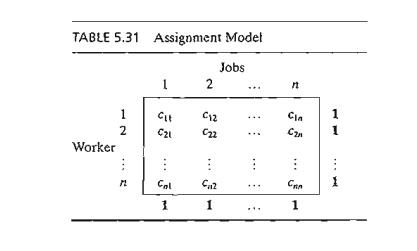
equals
the number of jobs, because we can always add fictitious workers or fictitious
jobs to satisfy this assumption.
The
assignment model is actually a special case of the transportation model in
which the workers represent the sources, and the jobs represent the destinations.
The supply (demand) amount at each source (destination) exactly equals 1. The
cost of "transporting" worker i to job j is cij. In
effect, the assignment model can be solved directly as a regular transportation
model. Nevertheless, the fact that all the supply and demand amounts equal 1
has led to the development of a simple solution algorithm called the Hungarian
method. Although the new solution method appears totally un-related to the
transportation model, the algorithm is actually rooted in the simplex method, just
as the transportation model is.
1. The Hungarian Method
We will
use two examples to present the mechanics of the new algorithm. The next
section provides a simplex-based explanation of the procedure.
Example
5.4-1
Joe
Klyne's three children, John, Karen, and Terri, want to earn some money to take
care of personal expenses during a school trip to the local zoo. Mr. Klyne has
chosen three chores for his children: mowing the lawn, painting the garage
door, and washing the family cars. To avoid antic-ipated sibling competition,
he asks them to submit (secret) bids for what they feel is fair pay for each of
the three chores. The understanding is that aU three children will abide by
their father's decision as to who gets which chore. Table 5.32 summarizes the bids
received. Based on this information, how should Mr. Klyne assign the chores?
The
assignment problem will be solved by the Hungarian method.
Step 1. For the original cost matrix,
identify each row's minimum, and subtract it from all
the entries of the row. .

Step 2. For the matrix resulting from
step 1, identify each column's minimum, and subtract it from all the entries of the column.
Step 3. Identify the optimal solution
as the feasible assignment associated with the zero ele-ments of the matrix
obtained in step 2.
Let pi and qj be the
minimum costs associated with row i
and column j as defined in steps 1 and 2, respectively. The row minimums of step 1
are computed from the original cost matrix as shown in Table 5.33.
Next,
subtract the row minimum from each respective row to obtain the reduced matrix
in Table 5.34.
The
application of step 2 yields the column minimums in Table 5.34. Subtracting
these values from the respective columns, we get the reduced matrix in Table
5.35.
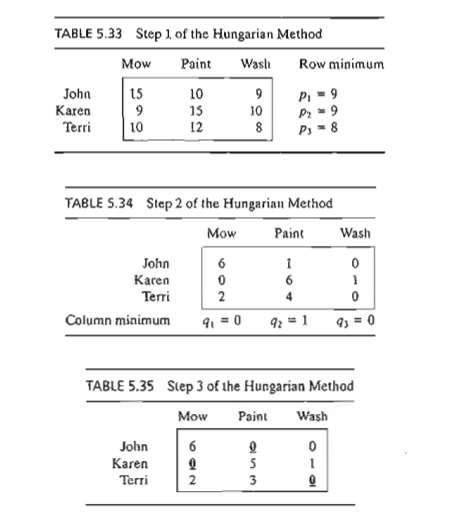
The cells
with underscored zero entries provide the optimum solution. This means that
John gets to paint the garage door, Karen gets to mow the lawn, and Terri gets
to wash the family cars. The total cost to Mr. Klyne is 9 + 10 + 8 = $27. This amount also will
always equal (p1 + p2
+ p3) + (q1 + q2
+ q3)
= (9 + 9 +
8)+(0 + 1 + 0) = $27. (A justification of this result is given in the next
section.)
The given
steps of the Hungarian method work well in the
preceding example because the zero entries in the final matrix happen to
produce a feasible assignment (in the
sense that each child is assigned a distinct chore). In some cases, the zeros
created by steps 1 and 2 may not yield a feasible solution directly, and
further steps are needed to find the optimal (feasible) assignment. The
following example demonstrates this situation.
Example 5.4-2
Suppose
that the situation discussed in Example 5.4-1 is extended to four children and
four chores. Table 5.36 summarizes the cost elements of the problem.
The
application of steps 1 and 2 to the matrix in Table 5.36 (using p1 = 1, p2 = 7, p3
= 4, p4
= 5, q1
= 0, q2
= 0, q3
= 3, and q4
= 0) yields
the reduced matrix in Table 5.37 (verify!).
The
locations of the zero entries do not allow assigning unique chores to all the
children. For example, if we assign child 1 to chore 1, then column 1 will be
eliminated, and child 3 will not have a zero entry in the remaining three
columns. This obstacle can be accounted for by adding the following step to the
procedure outlined in Example 5.4-1:
Step 2a. If
no
feasible assignment (with all zero entries) can be secured from steps 1 and 2,
(i) Draw
the minimum number of horizontal and
vertical lines in the last reduced matrix that will cover all the zero entries.
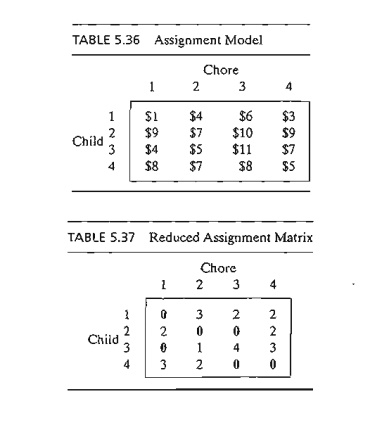
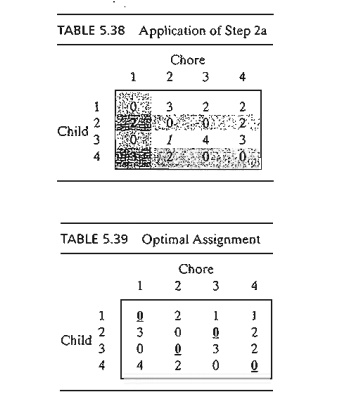
(ii) Select
the smallest uncovered entry,
subtract it from every uncovered entry, then add it to every entry at the
intersection of two lines.
(iii) If no feasible assignment can be
found among the resulting zero entries, repeat step 2a.
Otherwise, go to step 3 to determine the optimal assignment.
The
application of step 2a to the last matrix produces the shaded cells in Table
5.38. The smallest unshaded entry (shown in italics) equals 1. 111is entry is
added to the bold intersection cells and subtracted from the remaining shaded
cells to produce the matrix in Table 5.39.
The
optimum solution (shown by the underscored zeros) calls for assigning child 1
to chore 1, child 2
to chore 3, child 3 to chore 2, and child 4 to chore 4. The associated optimal
cost is 1 + 10 + 5 + 5 = $21.
The same cost is also determined by summing the pis, the qis,
and the entry that was subtracted after the shaded cells were determined-that
is, (1 + 7 + 4 + 5) + (0 + 0 + 3 + 0) + (1) = $21.
AMPL Moment.
File amplEx5.4-2.txt provides the AMPL model for the assignment model.
The model is very similar to that of the transportation model.
PROBLEM SET 5.4A
1. Solve the assignment models in Table 5.40.
a. Solve by the Hungarian method.
b. TORA Experiment. Express the problem as an LP
and solve it with TORA.
c. TORA Experiment. Use TORA to solve the problem as
a transportation model.

d. Solver Experiment. Modify
Excel file solverEx5.3-l.xls to solve the problem.
e. AMPL Experiment. Modify ampIEx5.3-1b.txt to solve
the problem.
2. JoShop needs to assign 4 jobs to 4 workers. The cost of performing a
job is a function of the skills of the workers. Table 5.41 summarizes the cost
of the assignments. Worker 1 cannot do job 3 and worker 3 cannot do job 4.
Determine the optimal assignment using the Hungarian method.
3. In the JoShop model of Problem 2, suppose that an additional (fifth)
worker becomes available for performing the four jobs at the respective costs of
$60, $45, $30, and $80. Is it economical to replace one of the current four
workers with the new one?
4.In the model of Problem 2, suppose that JoShop has just received a
fifth job and that the respective costs of performing it by the four current
workers are $20, $10, $20, and $80. Should the new job take priority over any
of the four jobs JoShop already has?
*5. A business executive must make the four round trips listed in Table
5.42 between the head office in Dallas and a branch office in Atlanta.
The price of a round-trip ticket from Dallas is $400. A discount of 25%
is granted if the dates of arrival and departure of a ticket span a weekend
(Saturday and Sunday). If the stay in Atlanta lasts more
than 21 days, the discount is increased to 30%. A one-way
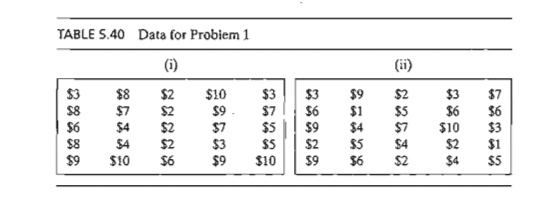
ticket between Dallas and Atlanta (either direction) costs $250. How
should the execu-tive purchase the tickets?
*6. Figure 5.6 gives a schematic layout of a machine shop with its
existing work centers des-ignated by squares 1,2,3, and 4. Four new work
centers, I, II, III, and IV, are to be added to the shop at the locations
designated by circles a, b, c, and d. The objective is to assign the
new centers to the proposed locations to minimize the total materials handling
traf-fic between the existing centers and the proposed ones. Table 5.43
summarizes the frequency of trips between the new centers and the old ones.
Materials handling equip-ment travels along the rectangular aisles intersecting
at the locations of the centers. For example, the one-way travel distance (in
meters) between center 1 and location b
is 30 + 20 = 50 m.
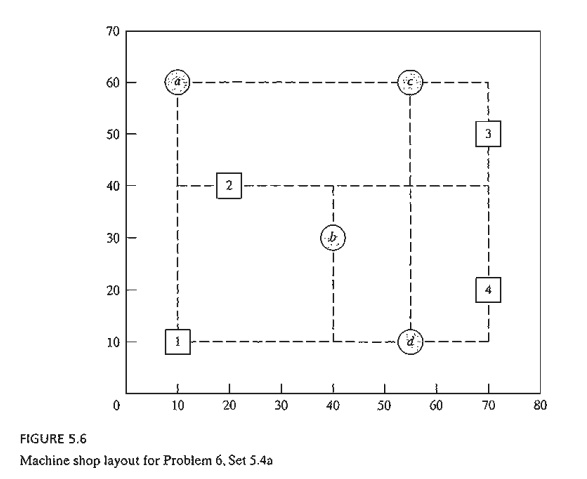
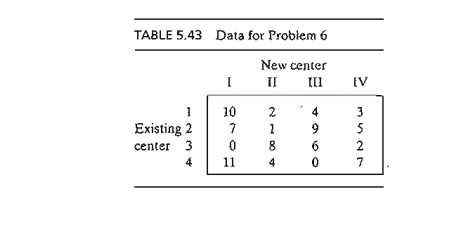
7. In the Industrial Engineering Department at the University of
Arkansas, INEG 4904 is a capstone design course intended to allow teams of
students to apply the knowledge and skills learned .in the undergraduate
curriculum to a practical problem. The members of each team select a project
manager, identify an appropriate scope for their project, write and present a
proposal, perform necessary tasks for meeting the project objectives, and write
and present a final report. The course instructor identifies potential projects
and provides appropriate information sheets for each, including contact at the
sponsoring or-ganization, project summary, and potential skills needed to
complete the project. Each design team is required to submit a report
justifying the selection of team members and the team manager. The report also
provides a ranking for each project in order of prefer-ence, including justification
regarding proper matching of the team's skills with the pro-ject objectives. In
a specific semester, the following projects were identified: Boeing F-lS, Boeing F-18, Boeing Simulation,
Cargil, Cobb-Vantress, ConAgra, Cooper, DaySpring (layout), DaySpring (material
handling), IB. Hunt, Raytheon, Tyson South, Tyson East, Wal-Mart, and Yellow
Transportation. The projects for Boeing and Raytheon require U.S. citizenship
of all team members. Of the eleven design teams available for this semester, four
do not meet this requirement.
Devise a procedure for assigning projects to teams and justify the
arguments you use to reach a decision.
2. Simplex Explanation of the Hungarian Method
The
assignment problem in which n workers
are assigned to n jobs can be
represented as an LP model in the following manner: Let cij be the
cost of assigning worker i to job j, and
define
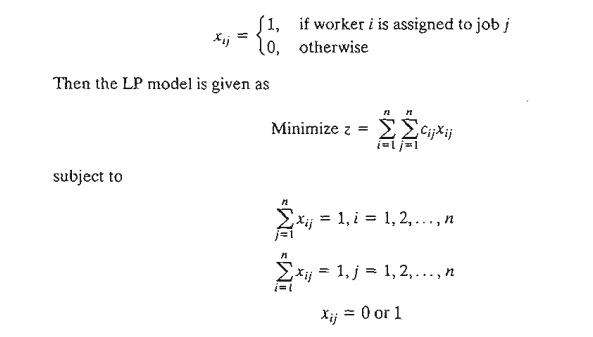
The
optimal solution of the preceding LP model remains unchanged if a constant is
added to or subtracted from any row or column of the cost matrix (cij). To prove
this point, let pi and qj be
constants subtracted from row i and column j. Thus, the cost
element cij is changed to
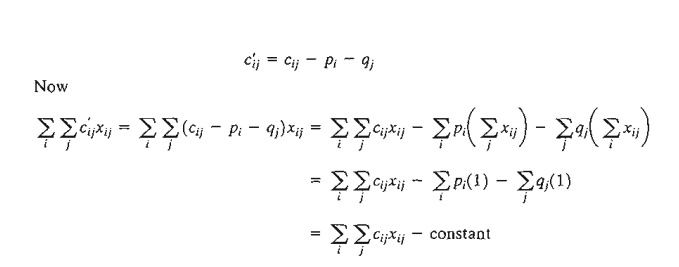
Because
the new objective function differs from the original one by a constant, the optimum
values of xij must be the
same in both cases. The development thus shows that steps 1 and 2 of the
Hungarian method, which call for subtracting pi from row i and then subtracting qj from
column j, produce an equivalent assignment model. In this regard, if a feasible
solution can be found among the zero entries of the cost matrix created by
steps 1 and 2, then it must be optimum because the cost in the modified matrix
cannot be less than zero.
If the created zero entries cannot
yield a feasible solution (as Example 5.4-2
demonstrates),
then step 2a (dealing with the covering of the zero entries) must be ap-plied.
The validity of this procedure is again rooted in the simplex method of linear
programming and can be explained by duality theory (Chapter 4) and the
complementary slackness theorem (Chapter 7). We will not present the details of
the proof here because they are somewhat involved.
The
reason (p1 + p2 + ... + pn) + (q1 + q2 + ... + qn) gives the optimal objective
value is that it represents the dual objective function of the assignment
model. This result can be seen through comparison with the dual objective
function of the transportation model given in Section 5.3.4. [See Bazaraa and
Associates (1990, pp. 499-508) for the details.]
Related Topics